warning VOLVO V90 CROSS COUNTRY 2018 Owner´s Manual
[x] Cancel search | Manufacturer: VOLVO, Model Year: 2018, Model line: V90 CROSS COUNTRY, Model: VOLVO V90 CROSS COUNTRY 2018Pages: 662, PDF Size: 11.93 MB
Page 5 of 662
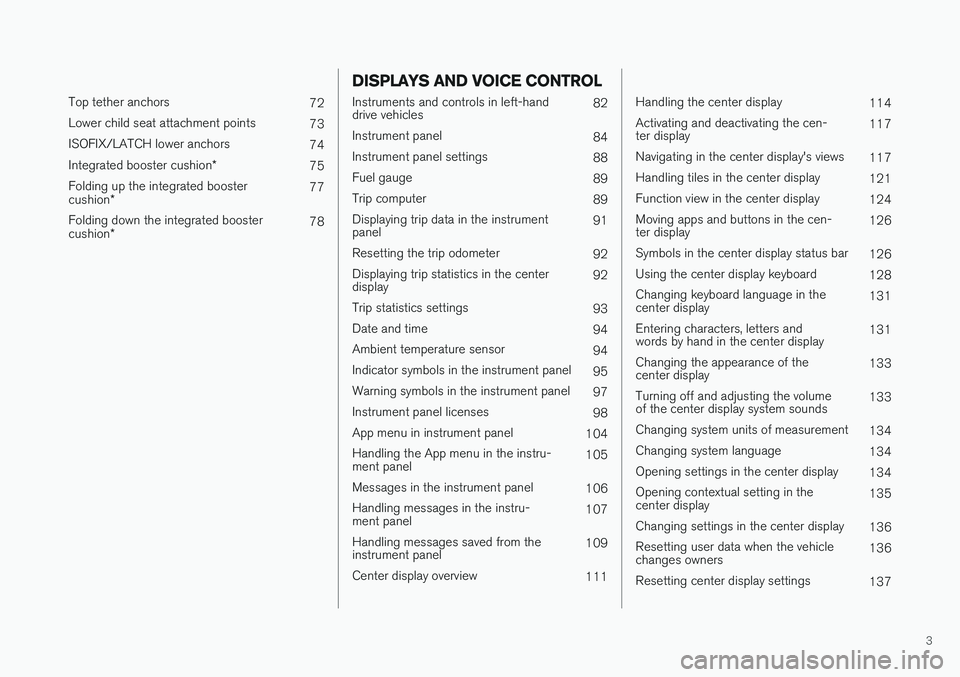
3
Top tether anchors72
Lower child seat attachment points 73
ISOFIX/LATCH lower anchors 74
Integrated booster cushion *
75
Folding up the integrated booster cushion * 77
Folding down the integrated boostercushion * 78
DISPLAYS AND VOICE CONTROL
Instruments and controls in left-hand drive vehicles
82
Instrument panel 84
Instrument panel settings 88
Fuel gauge 89
Trip computer 89
Displaying trip data in the instrumentpanel 91
Resetting the trip odometer 92
Displaying trip statistics in the centerdisplay 92
Trip statistics settings 93
Date and time 94
Ambient temperature sensor 94
Indicator symbols in the instrument panel 95
Warning symbols in the instrument panel 97
Instrument panel licenses 98
App menu in instrument panel 104
Handling the App menu in the instru-ment panel 105
Messages in the instrument panel 106
Handling messages in the instru-ment panel 107
Handling messages saved from theinstrument panel 109
Center display overview 111
Handling the center display114
Activating and deactivating the cen- ter display 117
Navigating in the center display's views 117
Handling tiles in the center display 121
Function view in the center display 124
Moving apps and buttons in the cen-ter display 126
Symbols in the center display status bar 126
Using the center display keyboard 128
Changing keyboard language in thecenter display 131
Entering characters, letters andwords by hand in the center display 131
Changing the appearance of thecenter display 133
Turning off and adjusting the volumeof the center display system sounds 133
Changing system units of measurement 134
Changing system language 134
Opening settings in the center display 134
Opening contextual setting in thecenter display 135
Changing settings in the center display 136
Resetting user data when the vehiclechanges owners 136
Resetting center display settings 137
Page 6 of 662
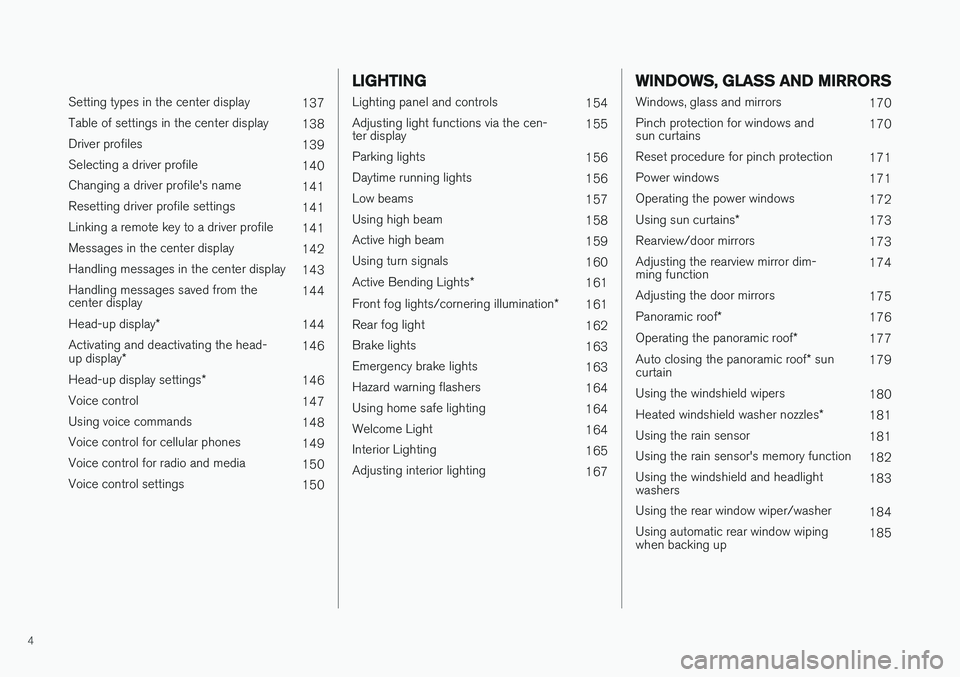
4
Setting types in the center display137
Table of settings in the center display 138
Driver profiles 139
Selecting a driver profile 140
Changing a driver profile's name 141
Resetting driver profile settings 141
Linking a remote key to a driver profile 141
Messages in the center display 142
Handling messages in the center display 143
Handling messages saved from the center display 144
Head-up display *
144
Activating and deactivating the head- up display * 146
Head-up display settings *
146
Voice control 147
Using voice commands 148
Voice control for cellular phones 149
Voice control for radio and media 150
Voice control settings 150
LIGHTING
Lighting panel and controls154
Adjusting light functions via the cen- ter display 155
Parking lights 156
Daytime running lights 156
Low beams 157
Using high beam 158
Active high beam 159
Using turn signals 160
Active Bending Lights *
161
Front fog lights/cornering illumination *
161
Rear fog light 162
Brake lights 163
Emergency brake lights 163
Hazard warning flashers 164
Using home safe lighting 164
Welcome Light 164
Interior Lighting 165
Adjusting interior lighting 167
WINDOWS, GLASS AND MIRRORS
Windows, glass and mirrors170
Pinch protection for windows and sun curtains 170
Reset procedure for pinch protection 171
Power windows 171
Operating the power windows 172
Using sun curtains *
173
Rearview/door mirrors 173
Adjusting the rearview mirror dim-ming function 174
Adjusting the door mirrors 175
Panoramic roof *
176
Operating the panoramic roof *
177
Auto closing the panoramic roof * sun
curtain 179
Using the windshield wipers 180
Heated windshield washer nozzles *
181
Using the rain sensor 181
Using the rain sensor's memory function 182
Using the windshield and headlightwashers 183
Using the rear window wiper/washer 184
Using automatic rear window wipingwhen backing up 185
Page 9 of 662
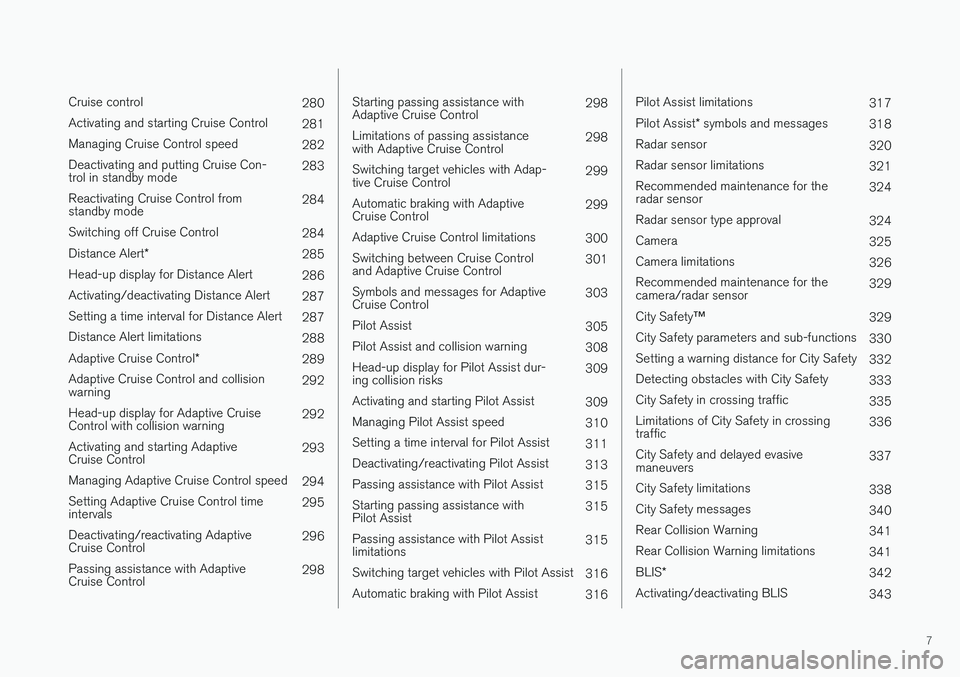
7
Cruise control280
Activating and starting Cruise Control 281
Managing Cruise Control speed 282
Deactivating and putting Cruise Con- trol in standby mode 283
Reactivating Cruise Control fromstandby mode 284
Switching off Cruise Control 284
Distance Alert *
285
Head-up display for Distance Alert 286
Activating/deactivating Distance Alert 287
Setting a time interval for Distance Alert 287
Distance Alert limitations 288
Adaptive Cruise Control *
289
Adaptive Cruise Control and collisionwarning 292
Head-up display for Adaptive CruiseControl with collision warning 292
Activating and starting AdaptiveCruise Control 293
Managing Adaptive Cruise Control speed 294
Setting Adaptive Cruise Control timeintervals 295
Deactivating/reactivating AdaptiveCruise Control 296
Passing assistance with AdaptiveCruise Control 298
Starting passing assistance with Adaptive Cruise Control298
Limitations of passing assistancewith Adaptive Cruise Control 298
Switching target vehicles with Adap-tive Cruise Control 299
Automatic braking with AdaptiveCruise Control 299
Adaptive Cruise Control limitations 300
Switching between Cruise Controland Adaptive Cruise Control 301
Symbols and messages for AdaptiveCruise Control 303
Pilot Assist 305
Pilot Assist and collision warning 308
Head-up display for Pilot Assist dur-ing collision risks 309
Activating and starting Pilot Assist 309
Managing Pilot Assist speed 310
Setting a time interval for Pilot Assist 311
Deactivating/reactivating Pilot Assist 313
Passing assistance with Pilot Assist 315
Starting passing assistance withPilot Assist 315
Passing assistance with Pilot Assistlimitations 315
Switching target vehicles with Pilot Assist 316
Automatic braking with Pilot Assist 316
Pilot Assist limitations317
Pilot Assist * symbols and messages
318
Radar sensor 320
Radar sensor limitations 321
Recommended maintenance for the radar sensor 324
Radar sensor type approval 324
Camera 325
Camera limitations 326
Recommended maintenance for thecamera/radar sensor 329
City Safety ™
329
City Safety parameters and sub-functions 330
Setting a warning distance for City Safety 332
Detecting obstacles with City Safety 333
City Safety in crossing traffic 335
Limitations of City Safety in crossingtraffic 336
City Safety and delayed evasivemaneuvers 337
City Safety limitations 338
City Safety messages 340
Rear Collision Warning 341
Rear Collision Warning limitations 341
BLIS *
342
Activating/deactivating BLIS 343
Page 10 of 662
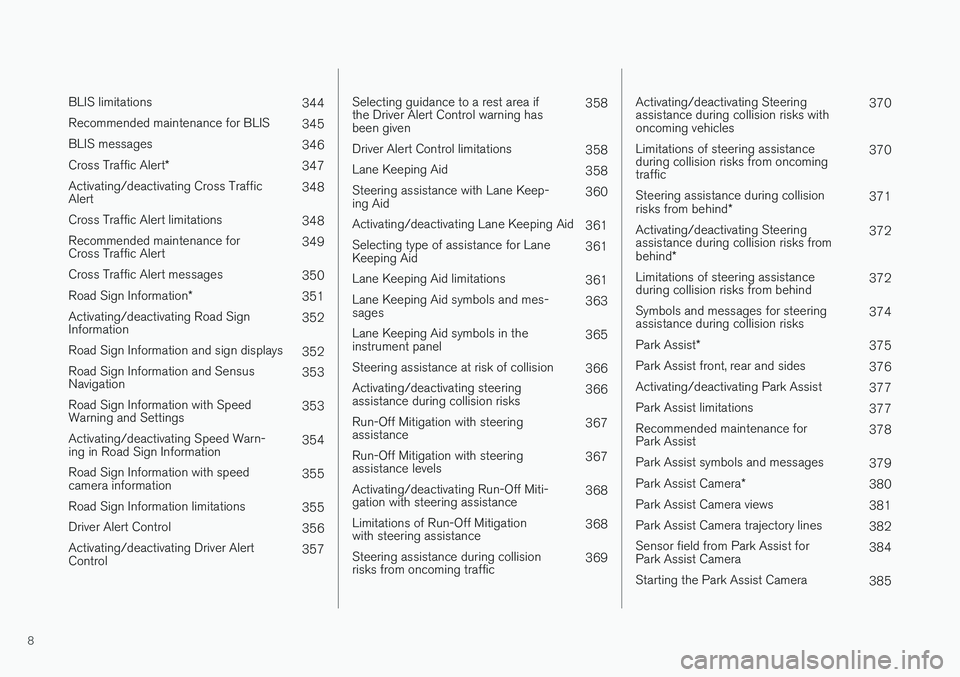
8
BLIS limitations344
Recommended maintenance for BLIS 345
BLIS messages 346
Cross Traffic Alert *
347
Activating/deactivating Cross Traffic Alert 348
Cross Traffic Alert limitations 348
Recommended maintenance forCross Traffic Alert 349
Cross Traffic Alert messages 350
Road Sign Information *
351
Activating/deactivating Road SignInformation 352
Road Sign Information and sign displays 352
Road Sign Information and SensusNavigation 353
Road Sign Information with SpeedWarning and Settings 353
Activating/deactivating Speed Warn-ing in Road Sign Information 354
Road Sign Information with speedcamera information 355
Road Sign Information limitations 355
Driver Alert Control 356
Activating/deactivating Driver AlertControl 357
Selecting guidance to a rest area if the Driver Alert Control warning hasbeen given358
Driver Alert Control limitations 358
Lane Keeping Aid 358
Steering assistance with Lane Keep-ing Aid 360
Activating/deactivating Lane Keeping Aid 361
Selecting type of assistance for LaneKeeping Aid 361
Lane Keeping Aid limitations 361
Lane Keeping Aid symbols and mes-sages 363
Lane Keeping Aid symbols in theinstrument panel 365
Steering assistance at risk of collision 366
Activating/deactivating steeringassistance during collision risks 366
Run-Off Mitigation with steeringassistance 367
Run-Off Mitigation with steeringassistance levels 367
Activating/deactivating Run-Off Miti-gation with steering assistance 368
Limitations of Run-Off Mitigationwith steering assistance 368
Steering assistance during collisionrisks from oncoming traffic 369
Activating/deactivating Steering assistance during collision risks withoncoming vehicles370
Limitations of steering assistanceduring collision risks from oncomingtraffic 370
Steering assistance during collision risks from behind * 371
Activating/deactivating Steering assistance during collision risks from behind * 372
Limitations of steering assistance during collision risks from behind 372
Symbols and messages for steeringassistance during collision risks 374
Park Assist *
375
Park Assist front, rear and sides 376
Activating/deactivating Park Assist 377
Park Assist limitations 377
Recommended maintenance forPark Assist 378
Park Assist symbols and messages 379
Park Assist Camera *
380
Park Assist Camera views 381
Park Assist Camera trajectory lines 382
Sensor field from Park Assist forPark Assist Camera 384
Starting the Park Assist Camera 385
Page 24 of 662
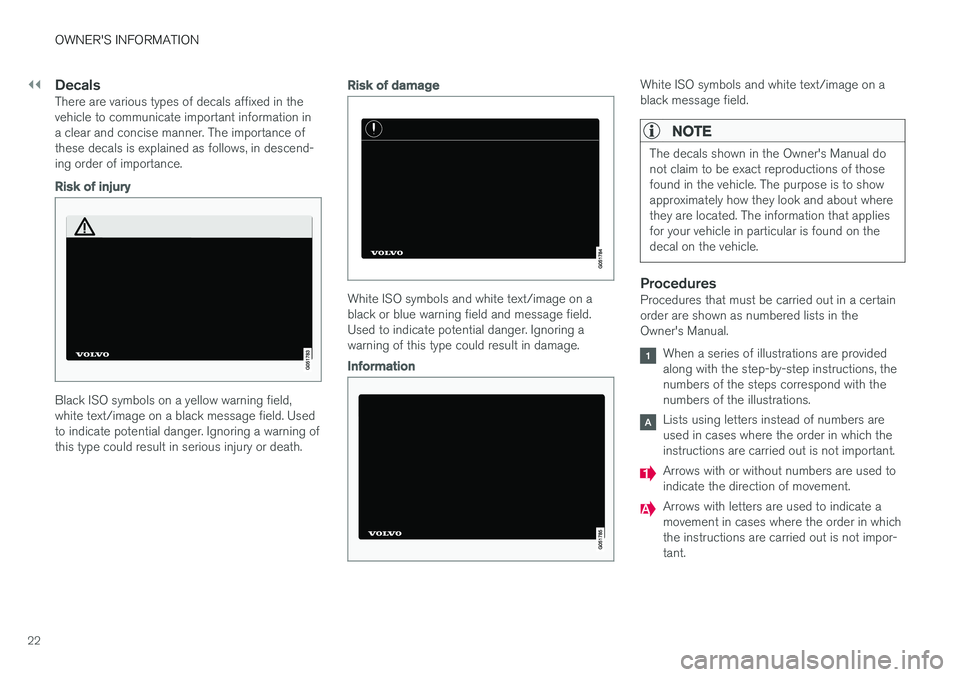
||
OWNER'S INFORMATION
22
DecalsThere are various types of decals affixed in the vehicle to communicate important information ina clear and concise manner. The importance ofthese decals is explained as follows, in descend-ing order of importance.
Risk of injury
Black ISO symbols on a yellow warning field, white text/image on a black message field. Usedto indicate potential danger. Ignoring a warning ofthis type could result in serious injury or death.
Risk of damage
White ISO symbols and white text/image on a black or blue warning field and message field.Used to indicate potential danger. Ignoring awarning of this type could result in damage.
Information
White ISO symbols and white text/image on a black message field.
NOTE
The decals shown in the Owner's Manual do not claim to be exact reproductions of thosefound in the vehicle. The purpose is to showapproximately how they look and about wherethey are located. The information that appliesfor your vehicle in particular is found on thedecal on the vehicle.
ProceduresProcedures that must be carried out in a certain order are shown as numbered lists in theOwner's Manual.
When a series of illustrations are provided along with the step-by-step instructions, thenumbers of the steps correspond with thenumbers of the illustrations.
Lists using letters instead of numbers are used in cases where the order in which theinstructions are carried out is not important.
Arrows with or without numbers are used to indicate the direction of movement.
Arrows with letters are used to indicate a movement in cases where the order in whichthe instructions are carried out is not impor-tant.
Page 31 of 662
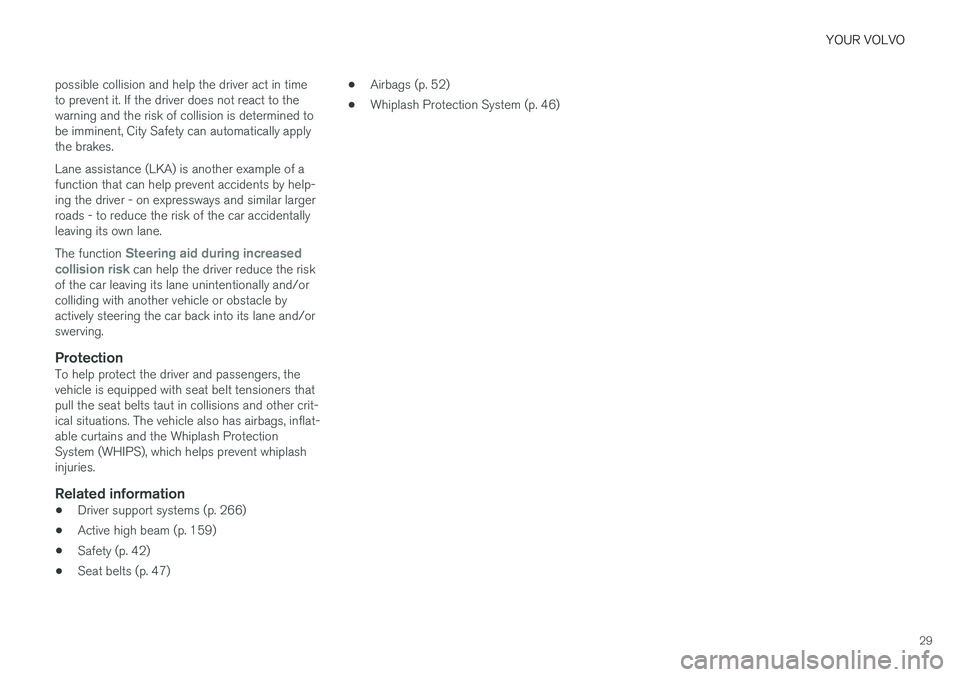
YOUR VOLVO
29
possible collision and help the driver act in time to prevent it. If the driver does not react to thewarning and the risk of collision is determined tobe imminent, City Safety can automatically applythe brakes. Lane assistance (LKA) is another example of a function that can help prevent accidents by help-ing the driver - on expressways and similar largerroads - to reduce the risk of the car accidentallyleaving its own lane. The function
Steering aid during increased
collision risk can help the driver reduce the risk
of the car leaving its lane unintentionally and/or colliding with another vehicle or obstacle byactively steering the car back into its lane and/orswerving.
ProtectionTo help protect the driver and passengers, thevehicle is equipped with seat belt tensioners thatpull the seat belts taut in collisions and other crit-ical situations. The vehicle also has airbags, inflat-able curtains and the Whiplash ProtectionSystem (WHIPS), which helps prevent whiplashinjuries.
Related information
• Driver support systems (p. 266)
• Active high beam (p. 159)
• Safety (p. 42)
• Seat belts (p. 47) •
Airbags (p. 52)
• Whiplash Protection System (p. 46)
Page 33 of 662

YOUR VOLVO
}}
* Option/accessory.31
Different types of information are shown in different displays depending on how the information should be prioritized.
Head-up display*
The head-up display presents information that the driver should react to immediately.For example, traffic warnings, speed information and navigation messages
*. Road sign information
and incoming phone calls are also shown in thehead-up display. These can be handled using theright-side steering wheel keypad or the centerdisplay.
Instrument panel
12" * instrument panel.
Page 37 of 662
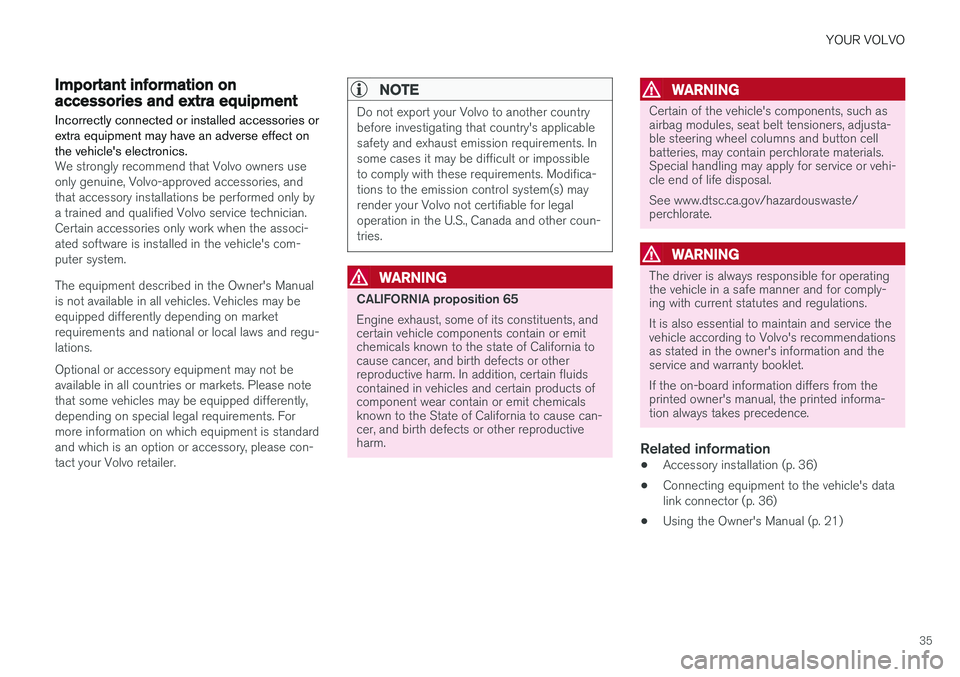
YOUR VOLVO
35
Important information onaccessories and extra equipment
Incorrectly connected or installed accessories or extra equipment may have an adverse effect onthe vehicle's electronics.
We strongly recommend that Volvo owners use only genuine, Volvo-approved accessories, andthat accessory installations be performed only bya trained and qualified Volvo service technician.Certain accessories only work when the associ-ated software is installed in the vehicle's com-puter system. The equipment described in the Owner's Manual is not available in all vehicles. Vehicles may beequipped differently depending on marketrequirements and national or local laws and regu-lations. Optional or accessory equipment may not be available in all countries or markets. Please notethat some vehicles may be equipped differently,depending on special legal requirements. Formore information on which equipment is standardand which is an option or accessory, please con-tact your Volvo retailer.
NOTE
Do not export your Volvo to another country before investigating that country's applicablesafety and exhaust emission requirements. Insome cases it may be difficult or impossibleto comply with these requirements. Modifica-tions to the emission control system(s) mayrender your Volvo not certifiable for legaloperation in the U.S., Canada and other coun-tries.
WARNING
CALIFORNIA proposition 65 Engine exhaust, some of its constituents, and certain vehicle components contain or emitchemicals known to the state of California tocause cancer, and birth defects or otherreproductive harm. In addition, certain fluidscontained in vehicles and certain products ofcomponent wear contain or emit chemicalsknown to the State of California to cause can-cer, and birth defects or other reproductiveharm.
WARNING
Certain of the vehicle's components, such as airbag modules, seat belt tensioners, adjusta-ble steering wheel columns and button cellbatteries, may contain perchlorate materials.Special handling may apply for service or vehi-cle end of life disposal. See www.dtsc.ca.gov/hazardouswaste/ perchlorate.
WARNING
The driver is always responsible for operating the vehicle in a safe manner and for comply-ing with current statutes and regulations. It is also essential to maintain and service the vehicle according to Volvo's recommendationsas stated in the owner's information and theservice and warranty booklet. If the on-board information differs from the printed owner's manual, the printed informa-tion always takes precedence.
Related information
• Accessory installation (p. 36)
• Connecting equipment to the vehicle's data link connector (p. 36)
• Using the Owner's Manual (p. 21)
Page 39 of 662
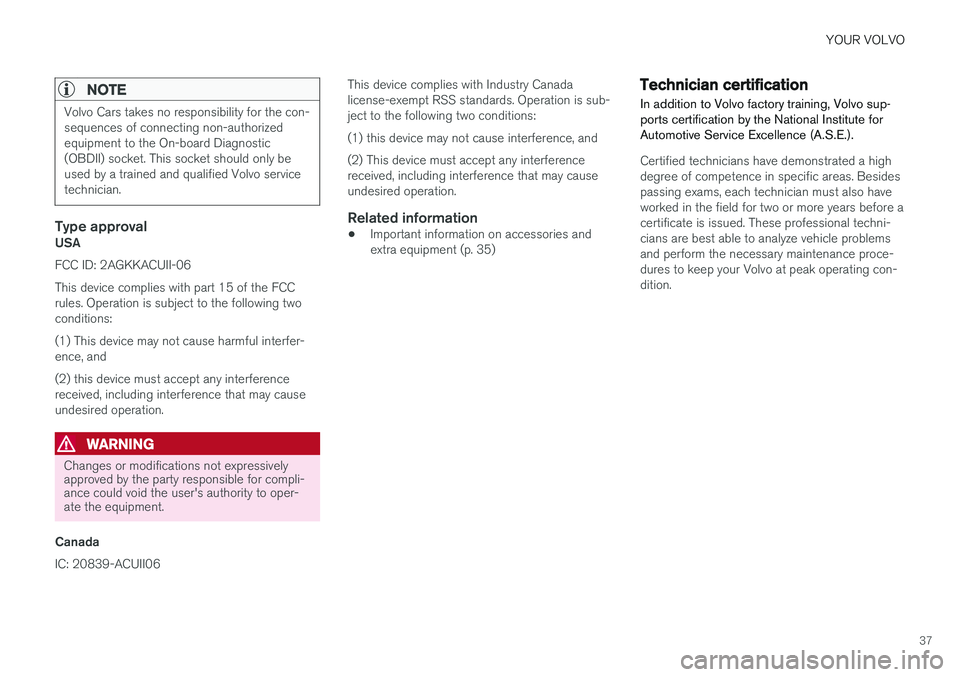
YOUR VOLVO
37
NOTE
Volvo Cars takes no responsibility for the con- sequences of connecting non-authorizedequipment to the On-board Diagnostic(OBDII) socket. This socket should only beused by a trained and qualified Volvo servicetechnician.
Type approvalUSA FCC ID: 2AGKKACUII-06 This device complies with part 15 of the FCC rules. Operation is subject to the following twoconditions: (1) This device may not cause harmful interfer- ence, and (2) this device must accept any interference received, including interference that may causeundesired operation.
WARNING
Changes or modifications not expressively approved by the party responsible for compli-ance could void the user's authority to oper-ate the equipment.
Canada IC: 20839-ACUII06 This device complies with Industry Canada license-exempt RSS standards. Operation is sub-ject to the following two conditions: (1) this device may not cause interference, and(2) This device must accept any interference received, including interference that may causeundesired operation.
Related information
•
Important information on accessories andextra equipment (p. 35)
Technician certification
In addition to Volvo factory training, Volvo sup- ports certification by the National Institute forAutomotive Service Excellence (A.S.E.).
Certified technicians have demonstrated a high degree of competence in specific areas. Besidespassing exams, each technician must also haveworked in the field for two or more years before acertificate is issued. These professional techni-cians are best able to analyze vehicle problemsand perform the necessary maintenance proce-dures to keep your Volvo at peak operating con-dition.
Page 41 of 662
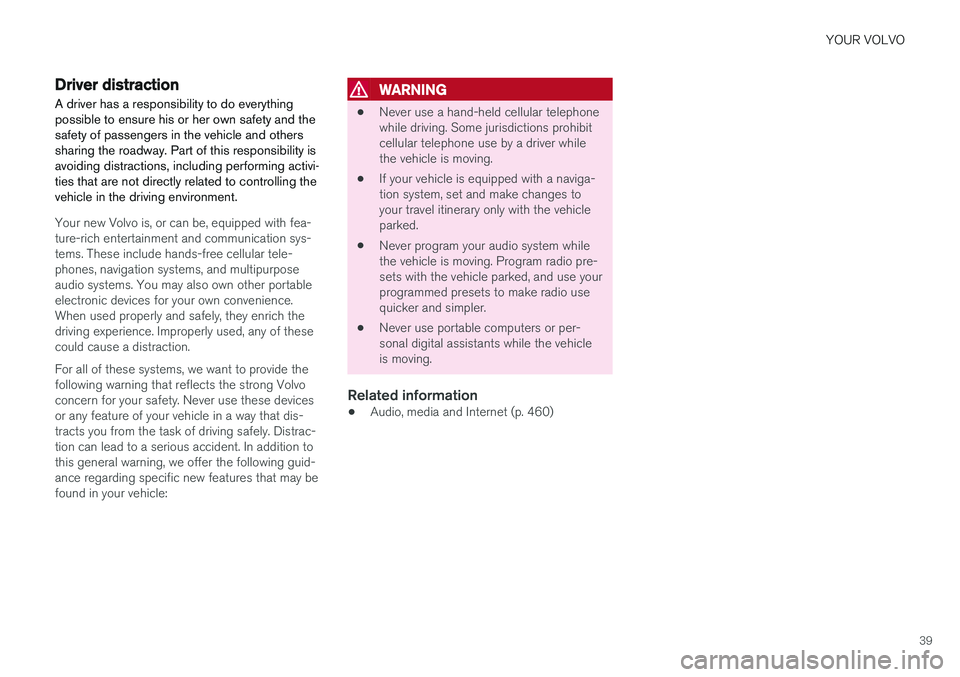
YOUR VOLVO
39
Driver distraction
A driver has a responsibility to do everything possible to ensure his or her own safety and thesafety of passengers in the vehicle and otherssharing the roadway. Part of this responsibility isavoiding distractions, including performing activi-ties that are not directly related to controlling thevehicle in the driving environment.
Your new Volvo is, or can be, equipped with fea- ture-rich entertainment and communication sys-tems. These include hands-free cellular tele-phones, navigation systems, and multipurposeaudio systems. You may also own other portableelectronic devices for your own convenience.When used properly and safely, they enrich thedriving experience. Improperly used, any of thesecould cause a distraction. For all of these systems, we want to provide the following warning that reflects the strong Volvoconcern for your safety. Never use these devicesor any feature of your vehicle in a way that dis-tracts you from the task of driving safely. Distrac-tion can lead to a serious accident. In addition tothis general warning, we offer the following guid-ance regarding specific new features that may befound in your vehicle:
WARNING
• Never use a hand-held cellular telephone while driving. Some jurisdictions prohibitcellular telephone use by a driver whilethe vehicle is moving.
• If your vehicle is equipped with a naviga-tion system, set and make changes toyour travel itinerary only with the vehicleparked.
• Never program your audio system whilethe vehicle is moving. Program radio pre-sets with the vehicle parked, and use yourprogrammed presets to make radio usequicker and simpler.
• Never use portable computers or per-sonal digital assistants while the vehicleis moving.
Related information
•Audio, media and Internet (p. 460)